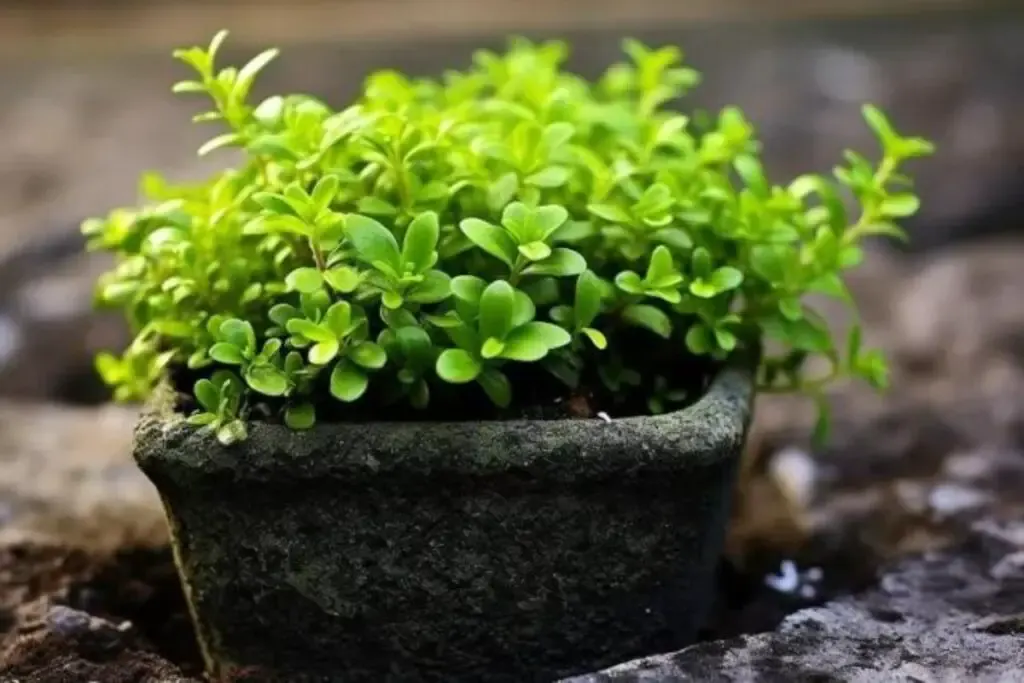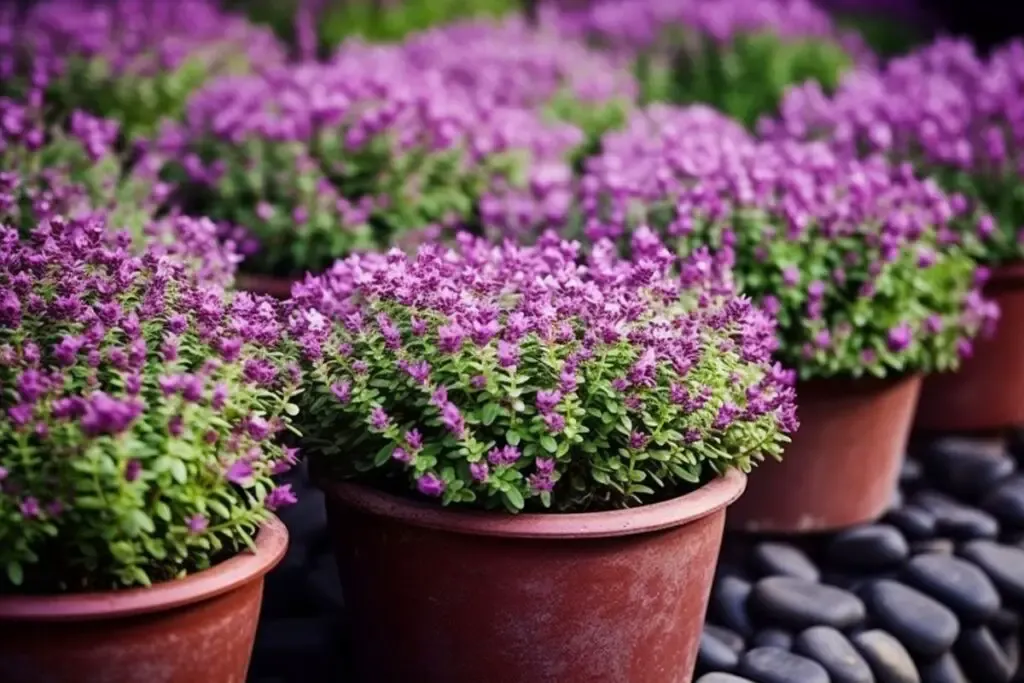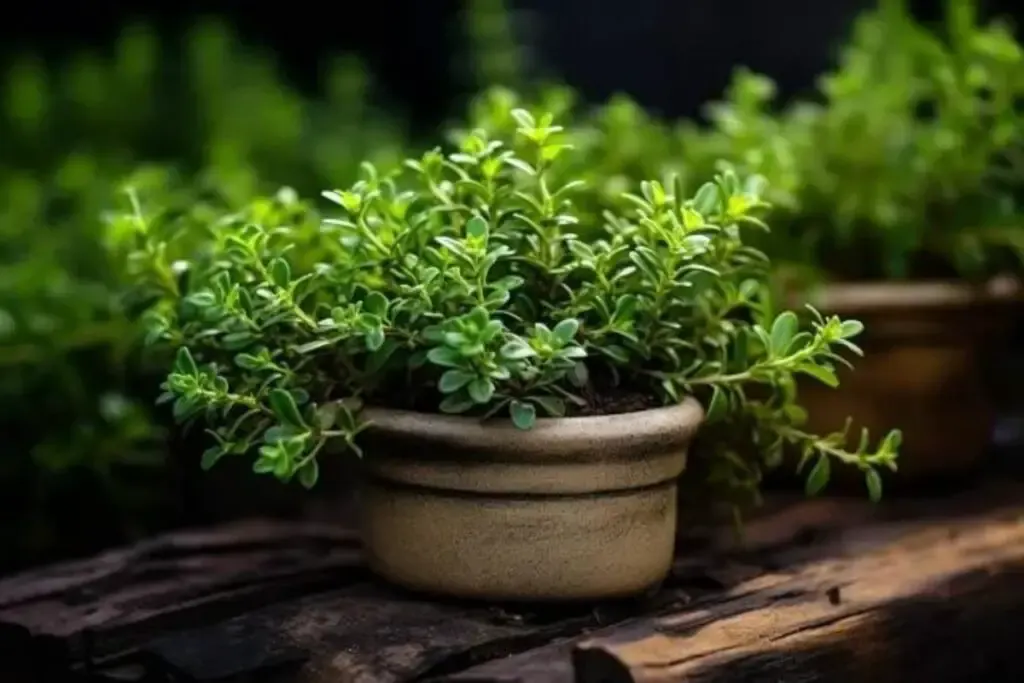Thyme, a Mediterranean native, is more than just a kitchen staple; it’s a gardener’s ally, thriving with minimal fuss and serving as a fragrant ground cover, especially when grown in pots.
Whether you have an expansive backyard garden or a modest balcony space, thyme adapts to its confines with grace, bringing with it a touch of greenery and the whisper of culinary inspiration.
Let’s embark on the journey of cultivating thyme in containers, where even the smallest of spaces can harness the essence of a herb garden.
Does Thyme Grow Well in Pots?
Absolutely! Thyme is particularly well-suited for pot cultivation. Its compact growth habit, drought tolerance, and low maintenance needs make it a star in the container gardening world.
When grown in pots, thyme benefits from excellent drainage—something this herb craves—and the potting mix can be tailored to its liking, ensuring the plant’s vitality. Plus, growing thyme in pots makes it easy to bring the plants indoors when the weather turns chilly, allowing for fresh herbs year-round.
But it’s not just about practicality. Potted thyme can be both ornamental and functional, gracing your patio or windowsill with its delicate foliage and tiny flowers that seem to buzz with visiting bees on sunny days. And when you brush against the leaves, they release their distinctive aromatic oils, making a stroll through your potted garden an immersive sensory experience.
Best Thyme Varieties for Pots
Thyme comes in numerous varieties, each with its unique flavor profile, growth habit, and flowering color. When selecting thyme for pot growing, consider the size of your container, your climate, and how you plan to use the herb. Here are three standout varieties that are particularly well-suited to life in pots:
1. Lemon Thyme (Thymus citriodorus)

Lemon thyme is a favorite among gardeners and chefs alike. Its leaves exude a refreshing citrus scent that can elevate a simple dish to something special. This variety is particularly hardy and adapts well to container living, offering a beautiful, sprawling display. Its green and yellow variegated leaves make it as visually appealing as it is tasty. In my experience, Lemon thyme pairs splendidly with chicken and fish dishes, making it a must-have in the culinary garden.
2. Woolly Thyme (Thymus pseudolanuginosus)

Woolly thyme is the plush carpet of the thyme family. With its soft, fuzzy leaves, it’s as much a joy to touch as it is to behold. This variety is less about culinary use—though it can be used in dishes—and more about aesthetics. It’s a low-grower, making it perfect for creating a lush, green mat in wide, shallow pots. It’s tolerant of light foot traffic, too, so if you’re crafting an aromatic path on your patio, Woolly thyme is your ally.
3. English Thyme (Thymus vulgaris)

The quintessential thyme used in kitchens worldwide, English thyme, is a robust variety with a classic flavor that pairs well with nearly any dish. It grows upright with a woody base and fares well in pots, where its growth can be contained and shaped.
As a perennial, it will come back year after year, offering its leaves for your culinary endeavors. In my garden, English thyme is a staple, and I often recommend it to fellow gardeners for its versatility and ease of care.
How to Grow and Care For Thyme in Pots
Growing thyme in pots is not just a space-saving measure; it’s a way to control the environment your herbs live in. Thyme, when given the proper attention and care, can thrive and bring you a bounty of flavor for your culinary exploits.
Let’s walk through the essentials for giving your potted thyme the best chance at a healthy, productive life.
Planting
Planting thyme is a straightforward affair. Begin with a quality potting mix and ensure you have healthy, disease-free starts or seeds.
I prefer to plant young thyme plants over seeds because they establish faster and you can harvest them sooner. Gently tease apart the roots when transferring them from their nursery pots to your containers, giving them a good foundation to grow from.
Pot Size
Thyme isn’t particularly fussy about space, but it does require adequate room for its roots to spread. A pot that’s at least 8 inches in diameter and equally deep is a good starting point, allowing room for growth without the pot becoming too heavy or cumbersome to move if necessary.
If you’re growing multiple plants in one container, give them about 12 to 18 inches of space between each other to allow for air circulation and growth.
Light
Thyme loves sunlight. To mimic the herb’s native environment, place your pots in a location where they will receive at least six hours of direct sunlight each day.
If you’re growing thyme indoors, a south-facing window is ideal. For those with less light, grow lights can be a worthy investment, ensuring your thyme gets the energy it needs no matter the weather outside.
Soil
Well-draining soil is critical for thyme. You want to avoid waterlogged roots at all costs, as thyme is prone to root rot in soggy conditions.
Amend regular potting soil with sand or perlite to increase drainage, and consider adding a bit of lime to mimic the slightly alkaline soils of the Mediterranean.
Water
When it comes to watering, thyme is on the drought-tolerant side of the spectrum. Allow the soil to dry out between waterings, and when you do water, do so thoroughly until water runs out of the drainage holes.
Be especially cautious not to overwater during the winter months when the plant’s water needs decrease.
Temperature and Humidity
Thyme is a hardy herb that can tolerate a range of temperatures, but it thrives in conditions that mirror its Mediterranean origins—warm and not too humid.
Outdoor pots can withstand a lot, but if you’re in an area with cold winters, consider bringing your thyme inside to protect it from freezing temperatures.
Fertilizer
Thyme isn’t a heavy feeder, but like all potted plants, it will eventually exhaust the nutrients in its soil. Use a balanced, slow-release fertilizer at the beginning of the growing season, or opt for a half-strength liquid fertilizer every few weeks during the spring and summer. Too much fertilizer can lead to lush foliage but diminished flavor, so use a light touch.
Pruning Potted Thyme
Pruning is an essential part of maintaining the health and vigor of your potted thyme. Not only does it help to keep the plant’s growth in check, but it also encourages a bushier growth habit and prevents the plant from becoming woody and sparse.
Start by regularly harvesting the top third of the plant, which can actually stimulate new growth and keep your thyme lush. Always use sharp scissors or pruning shears to make clean cuts, which will help prevent damage to the delicate stems.
As the season progresses, watch for any parts of the plant that may be dead or dying and prune those away to conserve the plant’s energy. Additionally, after the thyme flowers, make sure to prune back the flowering stems to encourage new leaves to grow. This will ensure that your plant continues to produce the aromatic leaves that are so cherished in cooking.
Remember, the more you prune and harvest your thyme, the more it grows. It’s a wonderful cycle that rewards you with fresh herbs and keeps your plants healthy!
Overwintering
Overwintering thyme is relatively simple, especially if you live in a region where winters are mild. However, if temperatures drop below freezing, you’ll need to take some extra steps to protect your potted thyme.
Firstly, if your thyme is outdoors, move the pots to a sheltered location, like against the house or under a patio cover, to protect them from harsh conditions.
For those in colder climates, bringing your thyme indoors before the first frost is essential. Place the pots in a sunny window and reduce watering since the plant’s growth will slow down during the winter. It’s also a good time to inspect for pests and treat any infestations before bringing the plants inside, as indoor conditions can sometimes exacerbate pest problems.
If your thyme does stay outdoors, consider mulching around the base of the plant with straw or wood chips to provide extra insulation. Wrapping the pot itself in burlap or bubble wrap can also help protect the roots from freezing.
With these winter care tips, your thyme should emerge in the spring ready for another season of growth and harvest. Remember, a little preparation goes a long way in ensuring the longevity and health of your potted herbs.
